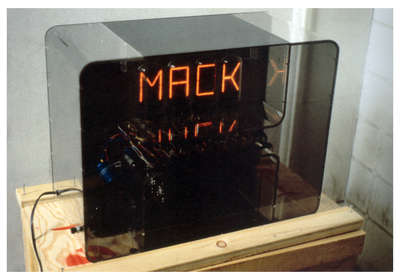This work harkens back conceptually to Normans 1966 random-number generator, with 4-letter words replacing the single digit readout. Although technically more sophisticated, it is strategically less complex, depending simply upon a few out-of-sync oscillators for its choice of the next word. All the words chosen are pronounceable, although not of any particular language.
[http://www.normill.ca/artpage.html] (consulted 27.10.08)
Four-Letter Word Generator caricatures the text as an art form and is thus related to Dadaist phonetic poetry up to and including Kurt Schwitter’s Ursonate (Original Sonata) from 1923.
The work is given an additional Dadaist component by the fact that legile words evolve as well (see for example the word ”MACK” in the illustration). In English, of course, a remarkable numbers of swearwords consist of four letters and are thus known as ”four-letter words”. These words only developed a truly scandalous quality after the creation of White’s work, when the US Supreme Court banned seven of them in 1978 following a complaint against a performance by the cabaret artist George Carlin in 1973: “fuck”, ”piss”, ”shit”, ”cunt” and ”tits” as well as the compound words with ”cock” and ”fuck”, ”cocksucker” and ”motherfucker”, which have usually been indexed since then in sogs, films etc. Therefore White’s work, through its title, also became a retrospective comment on censorship, although these particular ”four-letter words” appear extremely rarely among the innumerable possibilities and the object refers to other important words with four letters such as “love” or ”hate” in the same way.
Above all, the absurd level of the Four-Letter Word Generator means that the work represents a general reflection on language. It negates texts as a better alternative to images by turning the text into an image, but it also points to the fundamental development of language and comprehensible words. One can never be sure whether specific combinations don’t have a meaning in Finnish, Basque or Rhaeto-Romanic after all, and one recognises that all that is needed is an associative modulation from sounds to words in order to produce a semantically comprehensible language.
(Herzogenrath & Lähnemann 2009:21f.)
Size: 43 × 57 × 28 cm
Please compare work After the Fact


